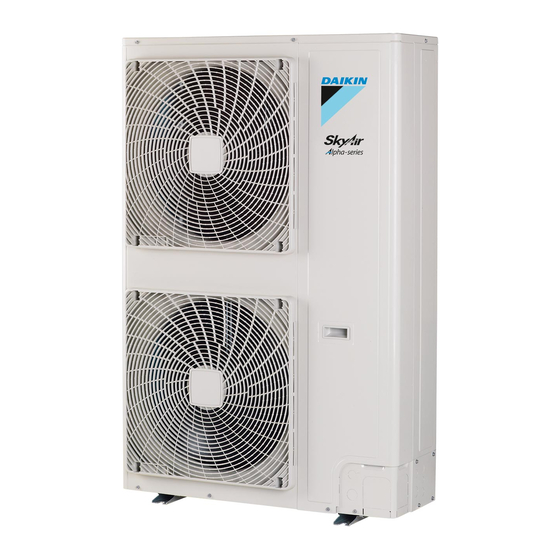
Advertisement
Table of Contents
- 1 Operation Manual
- 2 Table of Contents
- 3 Safety Precautions
- 4 What to Do before Operation
- 5 Installation Site
- 6 Operation Range
- 7 Operation Characteristics
- 8 Operation Procedure
- 9 Optimum Operation
- 10 Maintenance (for Service Personnel)
- 11 Not Malfunction of the Air Conditioner
- 12 Troubleshooting
- 13 Disposal Requirements
- Download this manual
Advertisement
Table of Contents

Summarization of Contents
Safety Precautions
Understanding Safety Classifications
Distinguishes WARNINGs (serious risk) and CAUTIONs (minor risk) for user safety.
Immediate Safety Actions
Actions for burning odor, repair, fuse usage, and natural disasters to prevent hazards.
Operational Safety Precautions
Environmental and Usage Hazards
Avoid oil vapor, flammable materials, gases, dust, and water to prevent unit damage and fire.
Installation, Earthing, and Storage Safety
Ensure professional installation, proper earthing, breaker use, and safe storage practices.
Child and Airflow Safety
Supervise children, protect from direct airflow, and avoid flammable sprays near the unit.
Unit & Service Safety Protocols
Component Handling and Work Safety
Handle remote controller carefully, ensure safety during high work, and avoid touching unit parts.
Installation Environment and Piping Safety
Avoid flammable gas, ensure proper drain piping, and use specified accessories.
Service Personnel Electrical Safety
Strict safety measures for service personnel, including power shutoff and residual voltage checks.
2. WHAT TO DO BEFORE OPERATION
System Types and Control Options
Understand system configurations (Pair, Multi) and remote controller types for proper operation.
Operation Modes and Group Control
Details on heat pump/cooling only modes and group control system precautions.
3. NAMES AND FUNCTIONS OF PARTS
Indoor and Outdoor Unit Components
Overview of indoor and outdoor unit parts and their functions.
Operation Temperature Ranges
Specifies the operational temperature ranges for cooling and heating modes.
4. INSTALLATION SITE
Ideal Installation Location
Select a well-ventilated area free from obstructions for optimal performance.
Prohibited Installation Areas
Lists environments to avoid, such as those with corrosive substances or high voltage fluctuations.
Installation Site Considerations
Wiring, Noise, and Drainage Safety
Ensure proper wiring, consider noise, drainage, and prevent thermal cut-out issues.
5. OPERATION PROCEDURE
Pre-Operation Power Management
Turn on power 6 hours before operation; avoid interrupting power during seasonal use.
6. OPERATION CHARACTERISTICS
Cooling and Heating Behavior
Details on frost, defrost, and warm-up behavior during cooling and heating operations.
Program Dry, Sound, and Airflow
Information on humidity control, sound pressure, and airflow direction adjustment.
Airflow Direction Control and Usage
Airflow Direction Control and Usage
How to adjust airflow and recommended positions for different modes.
Group Control Airflow Limitation
Limitation on individual airflow setting for slave units in group control.
7. OPTIMUM OPERATION
Cooling Efficiency and Energy Saving
Tips for efficient cooling, room temperature adjustment, and power saving.
Filter Cleaning and Device Placement
Filter cleaning reminders, electronic device placement, and power saving tips.
8. MAINTENANCE (FOR SERVICE PERSONNEL)
Service Safety Warnings
Critical safety warnings for service personnel regarding hazards like fire, shock, and injury.
Cleaning Air Filter and Grille
Detailed instructions for cleaning the air filter and suction grille, including safety notes.
Filter and Grille Cleaning Procedures
Air Filter Cleaning and Care
Methods for cleaning filters, temperature limits, and fire hazards.
Suction Grille Cleaning and Reassembly
Steps for cleaning the suction grille, reattaching parts, and clearing indicators.
Seasonal Cleaning and Startup
Grille, Panel, and Remote Cleaning
Procedures for cleaning grilles, panels, and remote controllers with specific cautions.
Seasonal Cleaning and Startup
Guidance for seasonal cleaning and unit startup after periods of non-use.
9. NOT MALFUNCTION OF THE AIR CONDITIONER
Normal Operation Variations Explained
Explanations for heating delays, intermittent stops, fan speed/airflow discrepancies.
Specific Operational Issues
Reasons for non-closing blades and white mist emission during operation.
Normal Operational Noises and Issues
Normal Operational Noises
Descriptions of common operational sounds like refrigerant flow and drain pump operation.
Dust, Odors, and Cooling Issues
Causes for dust emission, unit odors, and ineffective cooling performance.
10. TROUBLESHOOTING
Troubleshooting: Unit Not Operating
Checks for power issues: blown fuses, tripped breakers, or power failures.
Troubleshooting: Operational Problems
Troubleshooting: Operational Problems
Checks for blockages, filter issues, improper settings, timer use, or remote control conflicts.
Performance Issues and Safety Alerts
Addressing insufficient cooling/heating, safety device activation, switch malfunctions, and water leaks.
Troubleshooting: Error Codes and Disposal
Troubleshooting: Error Code Interpretation
How to view error codes and contact dealer for specific error information.
11. DISPOSAL REQUIREMENTS
Product and Battery Disposal Guidelines
Follow regulations for disposing of electrical items and batteries to protect the environment.
Professional Handling and Recycling
Emphasizes professional dismantling, refrigerant treatment, and specialized recycling facilities.
















Need help?
Do you have a question about the RZASG100 and is the answer not in the manual?
Questions and answers